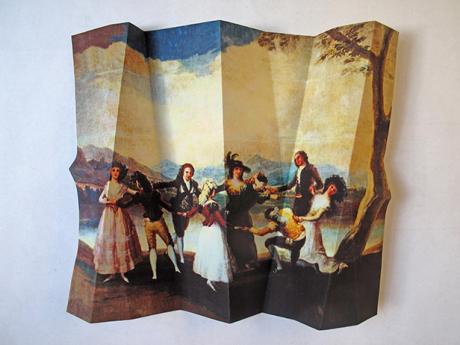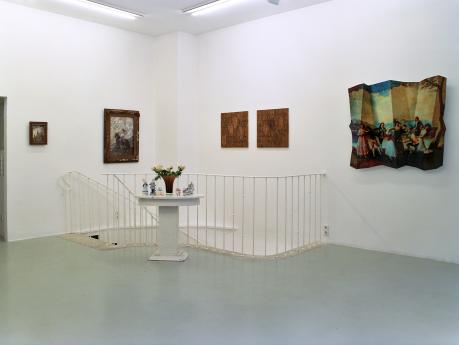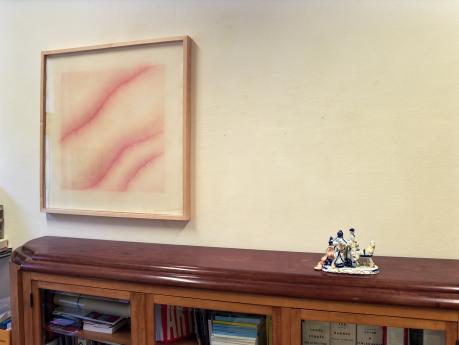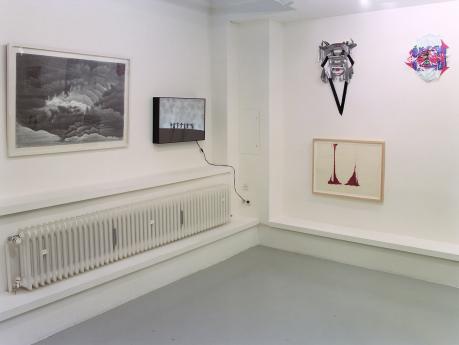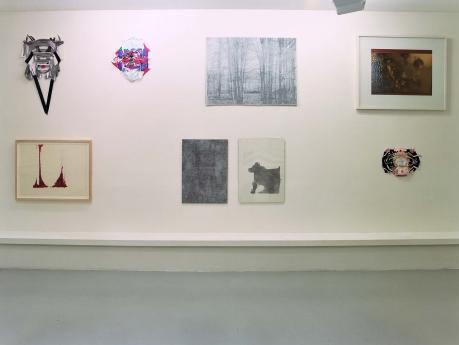Synthesis
/
kuratiert von Christina Petrinou
In der Ausstellung Synthesis (13. September – 26. Oktober 2013) präsentiert die griechische Kuratorin Christina Petrinou vierzehn griechische Künstler*, die ihre Arbeiten großteils in Bezug auf die Tapete von Klaus vom Bruch gestalten.
Auf dieser künstlerisch hochpolitischen Tapete beherbergen schöne, aber gefährliche Feuerquallen RAF Mitglieder, entspringen aus tödlichen Waffen Blumen. Das bourgeoise Motiv wird total gebrochen, der Künstler spielt mit dem Prinzip Tapete.
Darauf reagieren vierzehn Künstler aus Griechenland, einem Land, das zur Zeit politisch mit dem Rücken zur Wand steht. Was geschieht also in diesem Dialog in der Galerie Françoise Heitsch? Ein Experiment auf der Suche der Völkerverständigung? Eine Redefinition dessen, was das Bild im Bild verursacht? Oder schlicht und einfach ein Spiel mit Gegensätzen?
Die Idee zu dieser gemeinsamen Ausstellung entstand durch die Tapeten von Klaus vom Bruch. Er hatte sie für alle drei Räume der Galerie entwickelt. Er drückt in dieser Arbeit politische und private Gedanken aus. Dazu werden die kleinformatigen Arbeiten der griechischen Künstler einen Gegenpol einnehmen.
Panos Charalambous (‘56) ist ein Tabaksammler, der auf seiner Leinwand Tabakblätter aufgetragen hat, die er goldschimmernd bemalt.
Eleni Mylonas (‘44) zeigt eine Fotoarbeit auf der eine Jugendarbeit von Goya, Gallina Ciega von 1791, zu sehen ist. Diese auf einer gefalteten Tapetenpappe dargestellte Arbeit bekommt dadurch einen objekthaften Charakter.
Aliki Palaska (‘62) malt auf Tapeten nach alten Malern wie Caspar David Friedrich. Das Ergebnis ist befremdend und vertraut zugleich.
Maro Michalakakos (‘67) Zeichnungen entstehen durch Kratzen auf einer Veloursoberfläche. Das Ergebnis ist haptisch und zugleich erotisch.
Athanasia Vidali (‘86) zeichnet verletzte Körperfragmente. Sie zerschlägt auch alte Keramikelemente um sie neu zusammen zu setzen.
Poka-Yios (‘70) Kuchen und Portraitbilder sind bipolar, sie sind anziehend und abstoßend zugleich.
Panos Famelis (‘79) Objekte und Leinwände sind großformatig und stark pastös, sie entwickeln dadurch eine sehr starke, körperähnliche Ausstrahlung.
Valinia Svoronou (‘91) lässt sich von der Subkultur der Stadt inspirieren, dadurch entsteht eine Arbeit die sich stark an das Internet und das Modedesgin anlehnt.
Yiannis Theodoropoulos (‘62) ist ein Fotograf, der sein elterliches Haus benützt um seine Biographie sichtbar zu machen.
Nikos Papadopoulos (‘70) Zeichnungen sind durch einen Widerspruch gekennzeichnet, da er oft die fotografische Darstellung eines Objekts mit einer punktartigen, ihm sehr eigene und zeitaufwendige Arbeitsweise erzielt.
Lina Bebi (‘57) lässt sich von den Spitzen des Schattentheaters inspirieren und es entstehen dadurch Zeichnungen, die eine immaterielle Durchsichtigkeit vorführen.
Eva Marathakis (‘77) Zeichnung wird von der romantischen Erzählweise Emily Dickinsons beeinflusst.
Ioanna Ximeri (‘79) zeichnet auf vielen verschiedenen durchsichtigen Papierschichten, die sie dann beliebig stellenweise wegschneidet. Dadurch entsteh ein perspektivisch aufregendes Bild.
Myrto Xanthopoulou (‘81) Arbeit ist humorvoll und poetisch zugleich. Sie arbeitet mit trivialen Objekten, die eine Metamorphose erfahren.
*Lina Bebi, Panos Charalambous, Panos Famelis, Eva Marathaki,
Maro Michalakakos, Eleni Mylonas, Aliki Palaska, Nikos Papadopoulos, Poka- Yio, Valinia Svoronou, Yiannis Theodoropoulos,
Athanasia Vidali, Myrto Xanthopoulou, Ioanna Ximeri,
Klaus vom Bruch
The exhibition Synthesis (13 September – 26 October 2013) organized by the Greek curator Christina Petrinou displays works by fourteen artists*, which mainly revolve around Klaus vom Bruch’s wallpaper.
In this artistic and highly political wallpaper, beautiful yet dangerous lion’s mane jellyfish shelter RAF members, lethal weapons spring from flowers. The bourgeois motive is broken entirely, the artist plays with the principle wallpaper.
Fourteen artists from Greece react to this, a country, which politically has its back against the wall. So, what is happening in this dialogue at Galerie Françoise Heitsch? An experiment in international understanding? A redefinition of what creates an image within an image? Or simply a play with contradictions?
The idea of this group show is derived from Klaus vom Bruch’s wallpapers, which he created for all three rooms of the gallery. These works express political as well as private thoughts. In relation to this, the small-scale works created by the Greek artists function as a strong anti-pole.
Panos Charalambous (’56), a tobacco collector, arranged tobacco- leaves onto a canvas, which he consequently embellished with a shimmery golden tone.
The exhibited photographic work by Eleni Mylonas (’44) depicts an oil painting created by the young Goya (Gallina Ciega 1791). Since it is a folded wallpaper on cardboard, it assumes an object-like character.
Aliki Palaska (’62) paints on wallpapers in the style of the old masters such as Caspar David Friedrich. The outcome is both distancing and familiar.
Maro Michalakakos (’67) creates her drawings by scratching velours- surfaces. This process results in a work, which is simultaneously haptic and erotic.
Athanasia Vidali (’86) draws injured body parts. She also smashes ceramics in order to reassemble them anew.
The cakes and portraitures by Poka-Yio (’70) consist of a rather bipolar nature: they are appealing and repulsive at one and the same time.
A thick layer of paste is applied to the large-scale objects and canvases created by Panos Famelis (’79). His works, therefore, develop a body-like appearance.
Valinia Svoronou (’91) is inspired by the city’s subcultures; as a result, her work strongly evokes connotations revolving around the Internet and the field of fashion-design.
Yiannis Theodoropoulos (’62) is a photographer, who uses his parental home in order to depict and record his own biography.
Nikos Papadopoulos’ (’70) drawings are identified by an irreconcilable contradiction: appearing photographic at first glance, the representation of an object is accomplished by a dot-like, yet idiosyncratic and time-consuming approach.
Lina Bebi (’57) is inspired by the forms, which emerge from shadow plays. Her drawings, therefore, display an immaterial transparency.
The drawing by Eva Marathaki (’77) is informed by the romantic narrative style of Emily Dickinson.
Initially drawn on several layers of transparent paper, Ioanna Ximeri (’79) trims these later randomly in places. She thus creates a perspectively exhilarating image.
The work produced by Myrto Xanthopoulou (’81) is simultaneously humorous and poetic. She works with trivial objects, which undergo a metamorphic process.
* Lina Bebi, Panos Charalambous, Panos Famelis, Eva Marathaki, Maro Michalakakos, Eleni Mylonas, Aliki Palaska, Nikos Papadopoulos, Poka-Yio, Valinia Svoronou, Yiannis Theodoropoulos, Athanasia Vidali, Myrto Xanthopoulou, Ioanna Ximeri, Klaus vom Bruch.
Eleni Mylonas ( → Artist Website)
/
Biography
Fulbright Grant
Dokumentarfilmproduktion mit Fred W.Friendly
Praxissemester beim Look Magazine mit Arthur Rothstein
Praxissemester bei WGBH-TV Boston, Ma.
Catharwood Foundation Grant
Helen Lee Lasen Fellowship, Columbia University
Solo Exhibitions
“Fire in the Lake” / Zoumboulakis Galleries, Kolonaki, Athens
"The cursed serpent" / Benaki Museum, Athen
"Quasi Periodic Space" (Serie) / Foundation for Hellenic Culture, NY
"Afghanistan 1972" / Ileana Tounta Contemporary Art Center, Athen
"Universal Salvage" / Ileana Tounta Contemporary Art Center, Athen
"Nudes 1984" / Zoumboulakis Galerie, Kolonaki, Athen
"NY Graffiti" (Serie) / Zoumboulakis Galleries, Kriezotou, Athen
Group Exhibitions
“Handmade: On the Social Dimensions of Craft.” / Schwarz Foundation, Art Space Pythagorion, Samos, Greece. Curated by Katerina Gregou. In collaboration with the National Museum of Contemporary Art, Athens
“The Clown Spirit.” / Belgian Gallery, Belgium. Curated by Joanna DeVos
“Nuit Blanche.” / Museum of Natural History of Crete, Greece. Curated by Eirini Linardaki
Am I that image? / Museum of Contemporary Art, Skopje
LIVE@ArtAthina / Curated by Sozita Goudouna / Performance "SeaMonster Monk"
"Blind Date" / Curated by A. Volanakis, Museum of Contemporary Art, Rethymno
"Inside-out and Beyond" / Greek Consulate, New York.
"Quest for the Holy Grail" / Project Gallery, Athens.
"Welcome" / Project Gallery, Athens.
"Symptom Projects 9" / Curated by N. Papadopouos. Amphissa, Gr.
"In Loco Parentis." / Romantso, Athens
"IMAGO MUNDI" / Curatated by Beral Madra / Benetton Collection.
"DIASPORA" / Shiva Gallery, John Jay College, NYC
"PAPER MOON" / Museum of Contemporary Art Crete, Greece
"THE ARTIST/ KNIGHT" / Curated by Joanna DeVos / Gaasbeek Castle, Belgium. 2017
"CANAKKALE WALK 2017 HOMELAND"/ Curated by Christian Oxenius / Villa Schlikker, Kunsthalle / Osnabrück
"ex-pats" / Curated by Apostolis Artinos / Museum Alex Mylona, Athen
"WELCOME" / Museum of Contemporary Art Olivepress, Chania, Griechenland
CAMP Athens: When Art becomes the Solution / Kuratorin Ch. Petrinou, Athen
The Symptom Projects/ Kurator Apostolis Artinos, Amphissa, Griechenland
In Situations: Municipal Art Gallery "Brainstorming" / Kalamata
The Macedonian Museum of Art Collection at the Benaki Museum, Athen
Macedonian Museum of Contemporary Art "Memories" / Thessaloniki
The American College in Greece Art Collection Portrait Exhibition, Athen
Homage to Pineloppi Delta/ Athens College
"Art/Science" / University of Richmond (Virginia) Museums
"Art/Science" / Rutgers Camden Center for the Arts, Camden (NJ)
"Art and Mathematics" / The Cooper Union, NY
"In Tandem" / Eleni Mylonas & Ertugul Ates, Marmara Gallery, NY
“Off The Cloth II.” / WhiteBox, NYC. Curated by Karen Cordero & Yohanna M. Roa
Aliki Palaska
/
Biography
MFA Concodia Universitiy, Montreal
Solo Exhibitions
Group Exhibitions
"Revalue/ I.Part" / Galerie Francoise Heitsch, Munich
"Buffet"/ Martinos Antique and Fine Art Gallery, Athen
"Through the looking glass"/ Martinos Antique and Fine Art Gallery, Athen
"Zoo"/ Martinos Antique and Fine Art Gallery, Athen
"During the eclipses art mates"/ Camp, Athen
"Kiss from Greece"/ Womachine Galerie, Berlin
"Kiss from Greece"/ Stalger Galerie, Wien
Klaus vom Bruch ( → Artist Website)
/
Biography
Philosophie an der Universität Köln
Arbeitsstipendium des Kunstfonds Studienstiftung des Deutschen Volkes
1. Deutscher Videokunstpreis Marl Silbermedaille
Videofestival Locarno/ Ascona Kritikerpreis
Videofestival Montbeliard Chargesheimerpreis der Stadt Köln
Hamburger Bahnhof, Museum für Gegenwart, Berlin
Kunstmuseum Bonn, Bonn
Museum für Neue Kunst & Medienmuseum (ZKM), Karlsruhe
Kunsthalle zu Kiel der Christian-Albrechts-Universität, Kiel
Kolumba, Köln
Museum Ludwig, Köln
Kunsthalle, Bremen
Galerie für Zeitgenössische Kunst – GfZK, Leipzig
Folkwang Museum, Essen
Lenbachhaus, München
San Francisco Museum of Modern Art
Museum of Modern Art, New York
Long Beach Museum of Modern Art
Vancouver Art Gallery, Vancouver, British Columbia
Netherlands Media Art Institute – Montevideo/Time Based Arts, Amsterdam
Stedelijk Museum, Amsterdam
Künstlerhaus Bregenz
Solo Exhibitions
"Propaganda – eine Wiederholung" / Kunstpavillon Alter Botanischer Garten, München
Institute of Contemporary Arts, London
Galerie Eigen & Art, Leipzig
Group Exhibitions
"Generation Loss" / Julia Stoschek Collection, Düsseldorf / 10 Years Julia Stoschek Collection, kuratiert von Ed Atkins
"Dr. π und die Suche nach der Quadratur des Kreises" / Bernhard Knaus Fine Art, Frankfurt am Main
"ganz konkret" / Haus Konstruktiv, Zürich
CITYSCALE 2010 Istanbul / curated by Beral Madra, Deniz, Erbas, Dr. Conny Oßwald-Hoffmann und Françoise Heitsch, Austauschprojekt von Künstlern aus Istanbul und München, Lothringer 13, Städtische Kunsthalle München, München
"Das im Entschwinden Erfasste" / Videokunst im Museum Folkwang Museum Folkwang, Essen
"Inside Installations" / Presentation Collection S.M.A.K., SMAK Gent
"Bilder in Bewegung: Künstler & Video" / Film Museum Ludwig Köln
"Changing Channels" / MUMOK Wien
"RECORD > AGAIN! - 40jahrevideokunst.de" / Teil 2 Edith-Ruß-Haus für Medienkunst, Oldenburg
"RECORD > AGAIN! - 40jahrevideokunst.de" / Teil 2 Kunsthaus Dresden
"RECORD > AGAIN! - 40jahrevideokunst.de" / Teil 2 ZKM, Karlsruhe
"Art of Two Germanys/Cold War Cultures" / Los Angeles County Museum of Art, Los Angeles
"VIDEO PERFORMANCE: Models of Self-Reflection" / Ausstellungshalle zeitgenössische Kunst Münster
"Interstitial Zones: Historical Facts, Archaeologies of the Present and Dialectics of Seeing argos" / Brüssel
"40jahrevideokunst.de" / MAMCS Strasbourg
"RÜCKBLENDE" / Neue Galerie, Graz
"True Romance" / Kunsthalle Wien
EMAF 2007 / European Media Art Festival Osnabrück
European Media Art Festival - FINAL CUT – Medienkunst und Kino / Kunsthalle Dominikanerkirche, Osnabrück
"AMERICAN VIDEO-ART" / LAZNIA - Centre for Contemporary Art, Danzig
"Photo-Trafic" / Centre pour l´image contemporaine Saint-Gervais Genève, Genf CINEFUTURO, Arte Scienza, Rom VIDEONALE Bonn
"Presentations and video-selections" / Dorottya Gallery, Budapest
" It is hard to touch the real" / Grazer Kunstverein, Graz
"40jahrevideokunst.de - Teil 1" / K21 Kunstsammlung Nordrhein-Westfalen - im Ständehaus, Düsseldorf
"40jahrevideokunst.de, Teil 1" / Revision.zkm, ZKM, Museum für Neue Kunst & Medienmuseum, Karlsruhe
"Screening War - Zur Repräsentation von Krieg in der Videokunst" / ZKM, Museum für Neue Kunst & Medienmuseum, Karlsruhe
VIDEONALE 10 - Festival zur zeitgenössischen Videokunst / Kunstmuseum Bonn
"Zur Vorstellung des Terrors: Die RAF-Ausstellung" / Kunst-Werke Berlin e.V. KW Institute for Contemporary Art, Berlin
"VIDEO - Bildsprache des 21. Jahrhunderts" / NRW-Forum Kultur und Wirtschaft, Düsseldorf
"Gelijk het leven isS.M.A.K." / Stedelijk Museum voor Actuele Kunst, Gent
"Televisions - Kunst sieht fern" / Kunsthalle Wien (Halle 1, Halle 2 im MQ), Wien
"Klaus vom Bruch/Laura Cottingham & Leslie Singer - It´s a Man´s World" / Galerie Nächst St. Stephan - Rosemarie Schwarzwälder, Wien
"Seeing Time" / The Cramlich Collection, San Francisco Museum of Modern Art
"Kunst des 20. Jahrhunderts" / Nationalgalerie, Berlin
